Exploring Dish Soap as an Effective Floor Cleaner
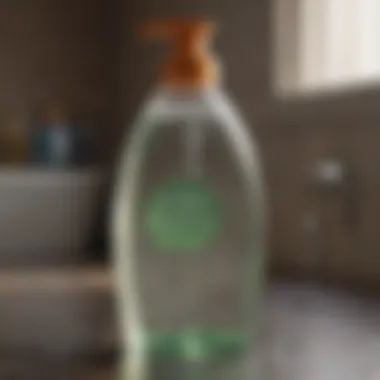
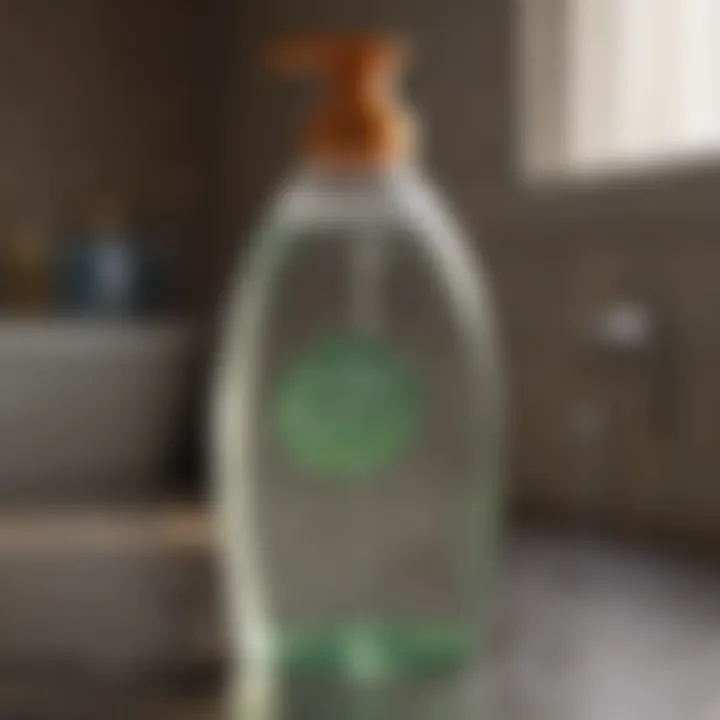
Intro
In an era where cleaning products are abundant and diverse, a common household item often finds itself overlooked—dish soap. While associated predominantly with washing up dishes and pots, its potential as a floor cleaner is both compelling and practical. As homeowners seek effective yet economical solutions to their cleaning woes, dish soap emerges as an unexpected ally.
The narrative surrounding dish soap's efficacy begins with its formulation. Comprised of surfactants, it excels in breaking down grease and dirt, making it a viable candidate for cleaning a variety of surfaces without the harmful chemicals found in many commercial cleaners. This article aims to delve deep into the various aspects of using dish soap for floor cleaning, from the components that provide its cleaning power to the methods that maximize its effectiveness on different types of flooring.
Understanding the science behind dish soap opens the door to informed decisions about housekeeping. Practical tips, safety considerations, and alternative cleaning agents will be explored, providing homeowners and cleaning enthusiasts a comprehensive guide to elevate their floor care routines. In a world that often complicates simplicity, rediscovering the humble dish soap could be the key to spruced-up, spotless floors.
Let’s dive into the heart of the matter to see how this household staple can transform your cleaning strategy.
Why Dish Soap?
Dish soap holds a unique position in the cleaning arsenal. It’s not just convenient; it comes with an array of benefits:
- Versatility: Effective on multiple surfaces including tiles, vinyl, and even hardwood when diluted properly.
- Safe for Pets and Children: Most dish soaps are non-toxic, making them a preferred choice in households with young kids or pets, offering peace of mind while cleaning.
- Cost-Effective: A small bottle can go a long way, providing a budget-friendly option without skimping on cleanliness.
However, it's essential to acknowledge that dish soap is not without its limitations. Some might find it less effective on stubborn stains or heavy-duty grime typically associated with industrial cleaners. Moreover, how a surface reacts to soap can vary based on its material composition, making it crucial to do a spot test before going all-in.
As we move forward in this article, we’ll explore concrete methods of application, delve into specific flooring types, and weigh the pros and cons of choosing dish soap as your go-to cleaner.
Intro to Dish Soap as a Cleaning Agent
The conversation around effective cleaning agents has evolved significantly in recent years. Dish soap, often relegated to the kitchen sink, is emerging as a surprising candidate for floor cleaning. But why does using dish soap hold such potential for this purpose? It’s about time we explore the composition, benefits, and reasons to consider dish soap beyond its usual domain.
Understanding the Composition of Dish Soap
Dish soap isn't just a rainbow of colors in a bottle; there's fascinating chemistry at play. Let’s unwrap what truly makes this cleaning agent effective.
Surfactants and Their Role
At the heart of any dish soap are surfactants. These molecules are basically the unsung heroes of cleaning. They have a unique structure, with one end that loves water (hydrophilic) and another that loathes it (hydrophobic). This duality enables surfactants to break down grease into smaller droplets, making it easier to wash them away. When we think about overall cleaning effectiveness, surfactants shine because they reduce surface tension, allowing a cleaning solution to spread and penetrate more deeply. It’s not just about removing dirt but doing so efficiently.
However, the trade-off involves how surfactants can leave residues behind if not rinsed properly. This is an aspect that needs careful consideration during cleaning.
Additives That Enhance Cleaning
Dish soaps often contain additives which further amplify their cleaning prowess. Ingredients like enzymes work tirelessly to target specific stains, while fragrances can leave floors smelling fresh and inviting. These additives make dish soap more than just a soapy liquid; they turn it into a multi-functional powerhouse. These enhancers boost the soap's ability to cut through tough grime while enhancing the user experience. It's like adding a cherry on top of an already great sundae.
However, not all additives are created equal. Some may cause allergic reactions in sensitive individuals, making it essential to read labels before jumping in.
Environmental Impact
When considering dish soap as a floor cleaner, one can’t ignore its environmental impact. Many brands pride themselves on creating formulas that are biodegradable, making them more appealing to eco-conscious users. Choosing a dish soap with plant-based ingredients is not just a trend; it's about contributing to a cleaner planet.
On the flip side, some dish soaps still contain phosphates or other harmful ingredients that can negatively affect waterways. Thus, the choice of dish soap has a broader implication than one might think. Overall, while dish soap can be a safe and environmentally friendly option, diligence is crucial in selecting the right product.
Why Consider Dish Soap for Floor Cleaning?
When it comes to maintaining the cleanliness of floors, many seek effective and economical solutions. Using dish soap for floor cleaning not only presents an accessible avenue for homeowners but also aligns with the increasing desire for safer and environmentally conscious cleaning practices. The appeal lies in dish soap's formulation, which makes it capable of tackling a variety of stains and residues often found on floors. Whether it's grease from cooking areas, dirt dragged in from outside, or spills from daily activities, dish soap can be a surprising ally in achieving a pristine home environment.
Effectiveness Against Various Stains
Grease and Oil Removal
Dish soap excels when tackling greasy messes. Think about the last time you accidentally splattered cooking oil while frying; this sticky foe can be a real headache. The specific nature of dish soap, with its surfactant components, allows it to break down the molecular structure of grease. This characteristic is valuable—it transforms what is often a challenging clean-up into a manageable task. When applied correctly, dish soap not only lifts away the greasy residue but also prevents it from smearing across the surface, making it an advantageous choice for kitchens and dining areas.
Dirt and Grime Breakdown
Dirt and grime, though often seen as a nuisance, can be easily eliminated with dish soap's unique cleansing properties. This soap is designed to penetrate and dislodge dirt particles, ensuring that they do not simply spread around. The foam that forms during use helps to encapsulate grime, making removal straightforward. This effectiveness is why many people find dish soap to be a practical solution rather than opting for harsher commercial cleaners that might be overkill. Its ability to loosen stubborn dirt creates a new benchmark for easy cleaning.
Residue from Food and Beverages
Spills are an inevitable part of life in any household, and the residues left behind—from juice and soda to sauces—can embed themselves into flooring material. Dish soap offers a gentle yet effective method to combat these sticky remnants. Its formulation ensures that even tough food residues can be dissolved without harsh scrubbing, which might damage delicate finishes. Many homeowners appreciate this because it doesn't just clean; it preserves the integrity of the flooring materials, allowing for fresh and spotless surfaces.
Cost Comparison with Commercial Cleaners
Budget-Friendly Options
One major selling point for dish soap as a cleaning agent is its economic advantage. Typically, a simple bottle of dish soap costs a fraction of what specialty floor cleaners do. Not only is it budget-friendly, but it also offers a multi-use function—cleaning dishes and floors—all from one product. This versatility makes it a popular choice among frugal households. Some might argue that price dictates quality; however, when it comes to dish soap, the results speak for themselves. Moreover, it’s often a lot easier to find than niche cleaners, which may require a trip to a specialty store.
Long-Term Savings Analysis
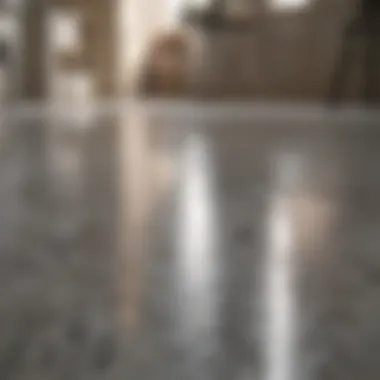
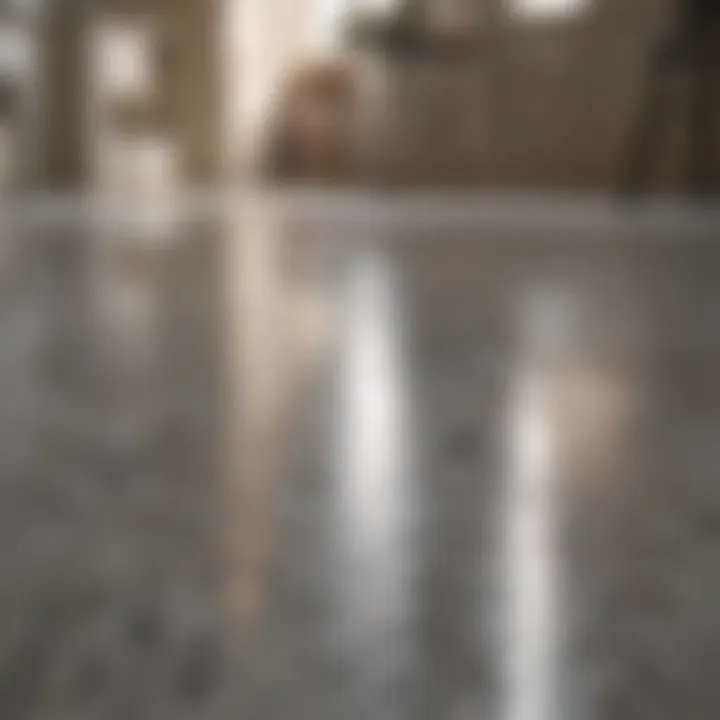
In examining long-term savings, the benefits of using dish soap extend beyond its initial purchase price. Over time, households using dish soap can see a significant reduction in their cleaning supplies budget. With fewer products cluttering under the sink, users can declutter not just their cupboards but their cleaning routines as well. Additionally, because dish soap is effective in smaller quantities, it also reduces the frequency of replenishing supplies, further solidifying its role as a cost-effective cleaning option. What started as a simple soap may save households dollars while ensuring that homes remain clean and safe.
Application Techniques for Optimal Cleaning
Effective cleaning goes beyond simply slapping some soap on a floor and mopping it up. The application techniques employed when using dish soap as a floor cleaner can significantly impact not only the end results but also the longevity of the flooring. Understanding how to prepare your cleaning solution and adopting effective mopping strategies can help you achieve the clean you desire while protecting your surfaces.
Preparation and Dilution
When it comes to using dish soap for floor cleaning, getting the right preparation and dilution is of utmost importance. A poorly mixed solution can either lead to inadequate cleaning or leave behind a slippery residue.
Recommended Ratios for Solution
The recommended ratios for mixing dish soap with water can vary depending on the type of mess one is tackling. A common guideline is a dilution of one to two tablespoons of dish soap per gallon of warm water. This ratio is beneficial because it strikes a balance between potency and safety.
A higher concentration might boost cleaning power but could also lead to soap residue that may be harder to rinse off, making it a tricky choice for anyone looking to maintain a pristine floor. In contrast, a diluted solution may not effectively lift stubborn stains, resulting in repeated effort. Knowing the right proportion based on the situation can drastically optimize cleaning efforts and results.
Testing for Compatibility
Before diving in, it’s wise to conduct a testing for compatibility. Not all surfaces react the same way to dish soap, and some materials may take on unexpected results. A small patch test in an inconspicuous area can save you from potential headaches later on.
It's often suggested to apply a diluted soap solution on a hidden spot and observe it for a short period. This technique allows you to see if there’s any adverse reaction, particularly in sensitive materials like hardwood or high-gloss finishes. This initial step is crucial since it can mitigate risks of damage that could arise from a careless application.
Effective Mopping Strategies
Once you’ve prepped your solution, it's time to think about the mopping strategies that will yield the best results. Each strategy contributes to the overall cleaning performance and can enhance the effectiveness of your dish soap solution.
Type of Mop to Use
Not all mops are created equal when it comes to cleaning with dish soap. For instance, a microfiber mop tends to be a top choice, as it is designed to pick up dirt effectively while requiring less water. This characteristic can be an advantage, allowing you to reduce the risk of oversaturating surfaces.
A string mop may seem appealing for its absorbency, but it can lead to excess water and longer drying times, especially on surfaces that aren't meant to hold moisture, such as certain types of hardwood. Choosing the right type of mop tailored to your floor and cleaning solution is key to achieving a thorough clean.
Stroking Methods for Best Results
Lastly, the stroking methods that you employ can greatly influence the outcome of your cleaning session. Utilizing broad, sweeping motions rather than vigorous scrubbing tends to produce a more even finish on surfaces. It spreads the cleaning solution evenly without the risk of scratching or damaging the finish.
Using a figure-eight motion can also be effective, as it helps lift dirt and grime without pushing it around. This method allows for a better distribution of the soapy solution, maximizing the cleaning potential and minimizing streaks or residue left behind.
Tip: Always make sure to frequently rinse your mop to prevent spreading dirt around the floor.
By mastering the techniques of preparation, dilution, selection of mop, and stroking methods, homeowners can simultaneously enhance the cleaning power of dish soap while safeguarding their flooring. Proper attention to these finer details can make the difference between a quick clean-up and a spectacular deep clean.
Surface Suitability of Dish Soap
When it comes to cleaning floors, it’s essential to consider which surfaces you’re dealing with. Not every cleaning agent is a one-size-fits-all solution, and that’s where dish soap shines in its versatility. The suitability of dish soap for different flooring types—hardwood, tile, vinyl, carpet, and rugs—affects not only its effectiveness but also its safety and long-term impact on the surfaces being cleaned.
Hardwood and Laminate Floors
Potential Risks and Precautions
Hardwood and laminate floors can be delicate. While dish soap is generally safe, overusing it can lead to buildup that may dull the finish. It’s crucial to use a mild solution; too much soap can create a slippery film, posing safety hazards in your home.
Additionally, some dish soaps contain additives that might damage the protective coating on laminate floors. Before you dive in, always test a small, inconspicuous area first. This precaution helps ensure that the soap won’t harm the surface—a simple step that goes a long way in preserving your flooring.
Frequency of Use Recommendations
How often should dish soap be utilized on hardwood or laminate? The consensus is to limit this cleaning method to a few times a month. Frequent use can lead to that pesky residue mentioned earlier, which can accumulate and actually trap dirt rather than remove it. A good rule of thumb is to assess your foot traffic: rooms with more action might require occasional dish soap use, while infrequently used spaces might just need a light dusting or a damp cloth.
Tile and Vinyl Surfaces
Advantages of Using Dish Soap
Tile and vinyl are often more forgiving regarding cleaning agents, and here’s where dish soap truly shows its worth. It effectively tackles grease and grime without risking damage. The non-toxic nature of dish soap makes it a prime candidate for cleaning in areas frequented by kids or pets.
Moreover, it can be mixed with warm water for a powerhouse solution that makes scrubbing away at your tiles a breeze. The only catch? Make sure it’s rinsed thoroughly, especially in kitchens or bathrooms where residue can become slippery.
Cleaning Procedure Variations
Cleaning tiles and vinyl with dish soap can adapt based on specific needs. For routine cleaning, a diluted mixture of soap and water is fantastic. But for tougher stains, consider letting a stronger solution sit for a bit. This soak time can make all the difference, breaking down stubborn grime for easier removal.
Using a microfiber mop? That’s an excellent choice, as it traps dirt and debris effectively. Just remember: whether using dish soap or another cleaner, always follow up with a rinsing procedure to avoid film—a small tradeoff that ensures your floors shine.
Carpet and Rugs
Special Considerations
When it comes to carpets and rugs, caution is the name of the game. Dish soap can be a lifesaver for spot cleaning because it’s gentler than many chemical alternatives. However, there’s a catch: using dish soap incorrectly can leave behind a soapy residue that attracts dirt. When using it, ensure you dilute the soap well and dab rather than rub, as vigorous scrubbing can damage fibers.
Spot Cleaning Techniques
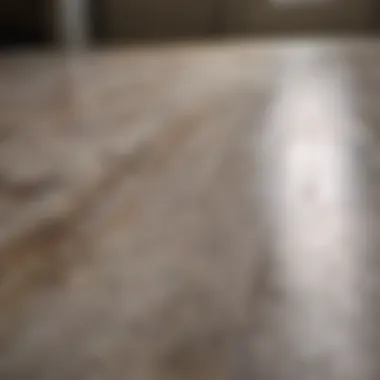
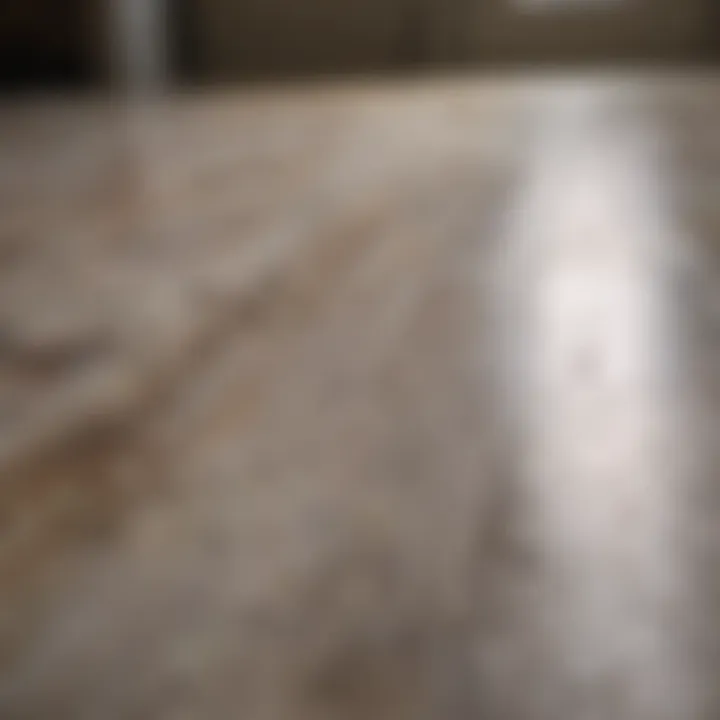
Spot cleaning with dish soap is about technique. First, blot the stain with a dry cloth to absorb excess liquid. Then, create a mixture of warm water and dish soap—aim for a light blend, as too much can backfire. Apply the solution sparingly, and use a clean cloth to dab it onto the stain, starting from the outside and working your way in. This method minimizes spreading the stain. Finally, rinse the area with a cloth dampened in plain water to remove any soap residue, a step that cannot be skipped if you want to keep your carpets looking fresh and tidy.
Advantages of Using Dish Soap
When it comes to cleaning floors, dish soap is often seen as a simple solution, but its benefits are anything but superficial. Understanding the advantages it brings to the table can help homeowners and cleaning enthusiasts make more informed choices. In this section, we’ll delve into the key benefits, such as its non-toxic nature, convenience, and versatility.
Non-Toxic and Safe for Families
Child and Pet Safety
One of the standout features of dish soap is its non-toxic makeup, making it a compelling choice for families with children and pets. Unlike many chemical cleaners that give off industrial scents or contain harsh substances, dish soap is relatively mild. Its gentle formulation means that spills or splashes aren’t a cause for panic; your little ones or furry companions won't come to harm from an accidental lick or a curious touch. This particular aspect of dish soap promotes peace of mind, allowing parents to focus on everyday life without worrying about hidden dangers.
A unique characteristic is that many dish soaps are biodegradable, which adds another layer of safety and environmental consciousness. This factor becomes increasingly relevant as contemporary consumers lean towards sustainable practices in their households. In short, the safety profile complements its effectiveness, making it a smart pick for conscientious users.
Benefits Over Chemical Cleaners
When comparing dish soap to traditional chemical cleaners, the advantages are significant. The primary element lies in its ability to cut through grease and grime without the harmful effects often associated with commercial products. For instance, while bleach and ammonia can leave harmful residues, dish soap rinses away fairly easily, leaving behind no toxic trail. This simplified cleanup process is invaluable in busy households.
Moreover, dish soap's mild formulation means it doesn’t typically cause allergic reactions or sensitivities like some chemical cleaners might. People with respiratory troubles or skin reactions often cite improvement when they switch to the gentler alternative of dish soap. While it's not all sunshine and rainbows—because even dish soap can sometimes leave a film if not rinsed properly—the advantages of being less abrasive and more environmentally friendly highlight its appeal.
Convenience and Accessibility
Readily Available Versatility
Dish soap can be found in almost every household, from small apartments to sprawling homes. Its ready availability positions it as a go-to solution for various cleaning tasks beyond just dishes. Think about it: a household already stocked with dish soap can also use it for floors, windows, countertops, and even car interiors. This kind of versatility simplifies the cleaning process because there’s no need to clutter the pantry with diverse cleaning products.
In addition, this widespread availability makes it a budget-conscious choice. There's no requirement to seek out specialized cleaners that might set you back a pretty penny. Instead, grabbing that ever-present bottle of dish soap means you can start cleaning right away. It’s like having a Swiss Army knife in your pantry; it adapts to the situation.
Simplicity in Selection
Finally, the simplicity surrounding dish soap extends to its selection. For many consumers, the variety available in supermarkets can be overwhelming—so many choices for one task! With dish soap, the decision-making process becomes much more straightforward. You don't need an advanced chemistry degree or a degree in marketing to figure out which cleaner will meet your needs. Just pick a brand you trust, and you're set.
The fundamental choice isn't complicated. Most types work similarly well against dirt and grease, so there's no need to sift through endless labels to find the right one. So, when you think about it, there’s a clean appeal to the simplicity and directness of this option. With no hidden forces behind its selection, dish soap can help streamline your cleaning routine effortlessly.
Key Takeaway: Dish soap shines as a cleaning agent in households, proving to be non-toxic, available, and easy to use. Its convenience positions it as a staple for families looking to maintain a clean environment without the headaches associated with commercial cleaners.
Limitations and Considerations
The use of dish soap as a cleaning solution for floors is often a topic of lively discussion. While dish soap is championed for its versatility and low cost, it’s essential to consider its limitations and what users should keep in mind. Understanding the drawbacks can equip homeowners and cleaning enthusiasts with knowledge that ensures effective cleaning without unintentional damage to surfaces.
Understanding Potential Residues
Soap Scum Formation
Soap scum formation is a phenomenon that can arise when dish soap is used on certain floors, particularly with hard water. The fats and minerals in the soap can lead to an unsightly buildup over time. This residue is incredibly frustrating as it dulls the appearance of your floors and may require significant effort to remove.
The persistent nature of soap scum makes it a concern; once it settles in, it can become a nuisance that detracts from the cleanliness of the area.
"The soap scum doesn’t just sit there; it lingers, complicating what should be an easy clean!"
One positive aspect is that it can often be scrubbed away with a bit of effort. This makes it a well-known issue yet one that is manageable with regular maintenance. However, if one isn’t careful with rinsing, it’s easy for soap scum to form, leading to regular cycles of cleaning that can feel like an uphill battle for many.
Need for Rinsing Techniques
When it comes to rinsing techniques, the effectiveness of using dish soap hinges heavily on ensuring that the cleaning residue doesn’t linger on the floor. When soap is left behind, it can attract dirt, making surfaces feel sticky over time. Rinsing is crucial to remove any remaining soap from the floor, which can be a vital factor in maintaining a clean environment. The rinsing process also prevents potential yellowing on lighter surfaces that may be caused by prolonged soap exposure.
If one finds joy in utmost cleanliness, implementing a rigorous rinsing technique is invaluable. For instance, using clean water while mopping twice can vastly improve the end result—leaving less chance for soap buildup and maintaining a pristine floor appearance.
On the flip side, an overly aggressive rinsing method might lead to excessive water on the surface, particularly on floors that absorb moisture. It is a fine balance that requires a little attention to detail.
Surface Damage Risks
Effects on Glossy Finishes
Glossy finishes can easily become a victim of dish soap if not managed correctly. The richness of the soap can dull or cloud glossy surfaces, leading to an unexpected loss of sheen over time. This phenomenon tends to arise when soap residues accumulate, leaving surfaces with a less than appealing finish. Although the initial wash with dish soap can appear effective, over time, the adverse effects reveal themselves, requiring additional maintenance to restore that sparkling look.
In essence, it becomes a trade-off between immediate cleaning satisfaction and potential long-term ramifications. A cautious approach, perhaps using a specially formulated cleaner for glossy finishes, could save time and effort down the line.
Long-Term Impact on Surface Coatings
The long-term impact on surface coatings is another factor to be considered. While dish soap can provide a top-notch clean, the regular use over time may wear down certain coatings, mostly if they are not resilient to soap formulations. Certain finishes may degrade under consistent exposure to soap, leading to costly repairs or refinishing work down the line.
Keeping a close tab on the specific care instructions for your flooring is crucial. Alternative cleaning methods, such as using vinegar or specialized floor cleaners, may sometimes be the better route to avoid damaging the integrity of the flooring.
When choosing dish soap for cleanliness, it is wise to approach with caution and assess the floor type in context. By understanding limitations in detail, one can minimize the risk of unwanted residues and damage, ensuring that the charm of home flooring lasts far longer.
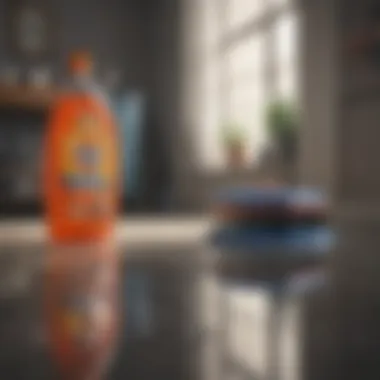
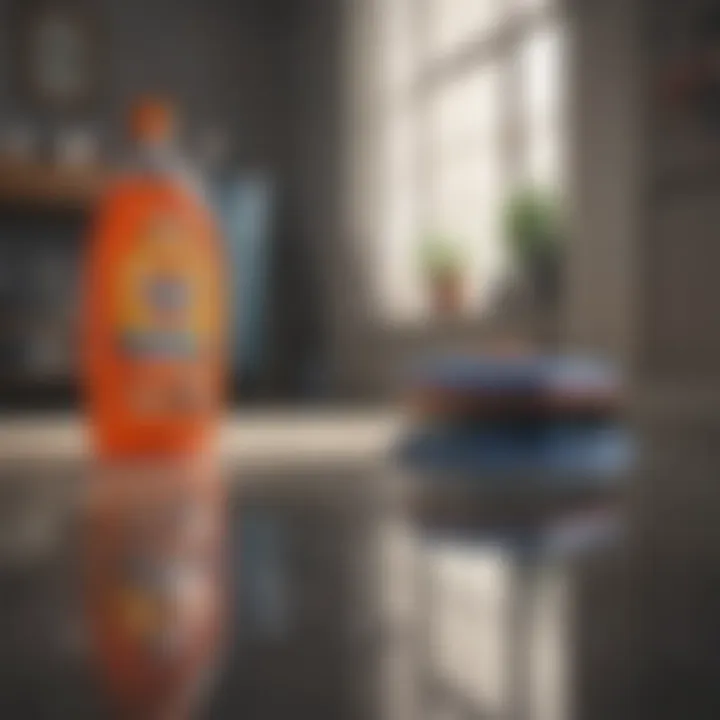
Safety Precautions When Using Dish Soap
When it comes to cleaning your floors with dish soap, safety should be top of mind. While dish soap is generally non-toxic and versatile, it's essential to keep certain precautions in place to protect your health and wellbeing. This section focuses on proper storage practices and health considerations associated with the use of dish soap in floor cleaning, emphasizing the importance of being informed when adopting this cleaning method.
Proper Storage Practices
Keeping Out of Children’s Reach
One important aspect of keeping dish soap safe is ensuring it is stored out of children’s reach. Kids are naturally curious, and their tendency to get into things can lead to accidents. Storing dish soap high on a shelf or locked in a cupboard reduces the risk of children ingesting it. This practice is not just about avoiding spills or messes; it's a way of prioritizing the safety of your household. In this article, we aim to highlight how proactive storage makes a significant difference in preventing hazardous situations.
A key characteristic of this strategy is the emotional comfort it provides parents. Knowing that your cleaning supplies are secured can lead to peace of mind when little ones are exploring. The unique feature of this practice is its simplicity; it does not require any fancy equipment or extensive organization. In contrast, the disadvantages could arise if such precautions are overlooked, potentially leading to unintended consequences.
Avoiding Chemical Contamination
Another aspect of safety is avoiding chemical contamination by ensuring that your dish soap does not mix with other cleaning agents. It’s vital to store dish soap separately from harsh chemicals and other cleaning products. This prevents reactions that could produce harmful fumes or residues. Understanding this aspect contributes to your goal of maintaining a safe cleaning environment.
The benefit of this practice lies in its proactive nature. It’s about creating a safe zone where only non-toxic products can interact. One unique feature is that it also helps maintain the integrity of the cleaning agents by preventing them from degrading or reacting negatively. On the flip side, if one isn’t careful or aware, combined products could lead to hazardous situations.
Health Considerations
Skin Reactions and Sensitivities
When using dish soap for cleaning floors, it's prudent to consider the potential for skin reactions and sensitivities. While many people tolerate dish soap without any problems, there are individuals whose skin may react adversely. This aspect is crucial for home cleaners to recognize, especially among those with sensitive skin or allergies. It’s about being mindful and prepared.
The main characteristic of knowing how dish soap behaves on the skin is the ability to practice caution. It is all about prioritizing one’s health over convenience. The unique feature of this consideration is incorporating protective measures like gloves during cleaning. Though the advantages of using dish soap often outweigh the risks, neglecting to pay attention to possible skin irritations can lead to discomfort.
Inhalation Risks During Use
Lastly, inhalation risks during use are yet another concern. While dish soap doesn’t generally produce strong fumes, using it in poorly ventilated spaces can increase exposure to any airborne particles or scents. It's essential to have sufficient airflow, especially when cleaning larger areas. This consideration is particularly beneficial for anyone with respiratory conditions.
The key characteristic here is awareness; understanding the conditions that could lead to increased inhalation risks informs safer practices. A unique aspect of this regulation is that it’s easily managed by simply ensuring good ventilation or using dish soap in small amounts. Though it often doesn’t provoke significant issues, neglecting this can lead to uncomfortable situations.
Remember, being proactive about safety not only enhances your cleaning routine but also safeguards your health and the wellbeing of those around you.
Alternative Cleaning Solutions
In the quest for a cleaner home, exploring alternative cleaning solutions holds significant importance. While dish soap is praised for its effectiveness and accessibility, other options exist that can either complement or substitute it. This section delves into two prominent alternatives: the combination of vinegar and baking soda, and commercially available eco-friendly cleaners. Each comes with unique benefits and considerations that homeowners, interior design enthusiasts, party hosts, and gardening aficionados should be aware of when making informed decisions for their cleaning strategies.
Efficacy of Vinegar and Baking Soda
Combined Solutions for Cleaning
When it comes to cleaning strategies, combining vinegar and baking soda is a tried-and-true method. This dynamic duo offers a powerful cleaning punch, making it a popular choice among those who prefer natural solutions. One key characteristic of combined solutions is their ability to tackle various stains and odors without the harsh effects of synthetic chemicals.
The unique feature of this mixture is its effervescence, which occurs when baking soda (a base) meets vinegar (an acid). This reaction not only assists in lifting grime but also provides a thorough cleaning that can leave surfaces sparkling. An advantage of these solutions is their non-toxic nature, making them ideal for homes with children or pets. On the flip side, the need to keep ratio and timing in mind can be seen as slightly inconvenient, as improper mixing might lead to ineffective results.
Comparison with Dish Soap's Efficacy
Discussing the comparison with dish soap highlights an interesting facet of alternative cleaning agents. While dish soap excels at cutting through grease and sticky residues, vinegar and baking soda operate differently. Notably, a key characteristic of this comparison lies in vinegar's natural deodorizing properties, allowing it to neutralize odors better than dish soap alone. This makes such combined solutions attractive for maintaining freshness in between regular cleanings.
Evaluating their effectiveness shows that while dish soap is excellent for everyday cleaning tasks, vinegar and baking soda shine in challenging situations, such as removing tough stains or eliminating unpleasant smells. However, the unique feature of dish soap is its sudsing ability, which can provide a physical cleaning action that a non-sudsing agent like vinegar lacks. Thus, while both options have their advantages, knowing when to use one over the other can enhance the overall cleaning routine.
Commercial Eco-Friendly Options
Market Analysis of Green Cleaners
The move towards sustainable living has birthed a significant interest in eco-friendly cleaning solutions. A market analysis reveals that there’s been a steady rise in the availability and variety of green cleaners designed specifically for households. A key characteristic of these cleaners is their formulation, often incorporating plant-based ingredients that are biodegradable and free from harsh chemicals. This makes them not only safer for the family but also kinder to the environment.
Understanding the market helps in highlighting the strengths of these options, such as promoting a healthier indoor air quality and reducing chemical exposure. One unique feature is their packaging, which often emphasizes sustainability, striving to impress eco-conscious consumers. Nevertheless, price points can sometimes be higher than traditional cleaners like dish soap, presenting a potential disadvantage for budget-minded shoppers.
Evaluating Effectiveness against Dish Soap
When evaluating the effectiveness of these eco-friendly cleaners against dish soap, it becomes clear that both have their merits. Commercial green cleaners often aim for an all-in-one functionality, targeting various types of dirt and stains, which can make them a convenient choice. A key characteristic here is that many green cleaners are formulated to be effective on multiple surfaces, similar to dish soap. This versatility can be appealing for people looking to streamline their cleaning supplies.
On the other hand, dish soap has a proven track record when it comes to cutting through grease, making it a reliable option for kitchens and heavily trafficked areas. The downside is that not all eco-friendly cleaners will match this specific efficacy, particularly when it comes to sticky residue. Therefore, knowing the strengths and weaknesses of each can empower consumers to make the right choice for their specific cleaning needs.
Ultimately, exploring these alternative solutions expands the toolkit available to homeowners and cleaning enthusiasts, providing them with varied approaches to maintaining cleanliness while considering the health of their families and the planet.
Finale
In summary, the examination of dish soap as a floor cleaner serves as an important reminder of the myriad of cleaning options available to homeowners. Its accessibility and effectiveness put it on the map, especially for those seeking quick solutions without the need to delve deep into commercial cleaning products. Using dish soap can simplify your cleaning routine, striking a balance between efficiency and safety, especially in homes with children and pets.
Summarization of Key Points
Final Thoughts on Usage
Dish soap’s versatility stands out as a defining factor when it comes to practical cleaning solutions. It caters to a wide range of cleaning requirements, from tackling typical dirt to more stubborn stains. Being user-friendly, it's often the go-to option for many, and its non-toxic nature makes it a favorable choice for numerous households. However, the characteristics that make it popular also come with a necessity for discernment—too much soap can lead to residue that could complicate future cleaning efforts.
Recommendations for Readers
When considering the use of dish soap for floor cleaning, it is beneficial to approach with a measure of caution. While dish soap is a strong contender against grime, it is essential to test its suitability on various surfaces before committing fully. Adopting a practice of dilution is another key piece of advice—never go in full strength unless you are sure of the surface compatibility. This way, you can yield the intended benefits without facing unwanted side effects like soap scum or dull finishes. Readers should keep in mind that while dish soap is a reliable choice, staying informed about proper techniques will enhance its effectiveness significantly.
The right approach can make dish soap not just a cleaning tool, but a transformative ally in the quest for clean, safe living spaces.







